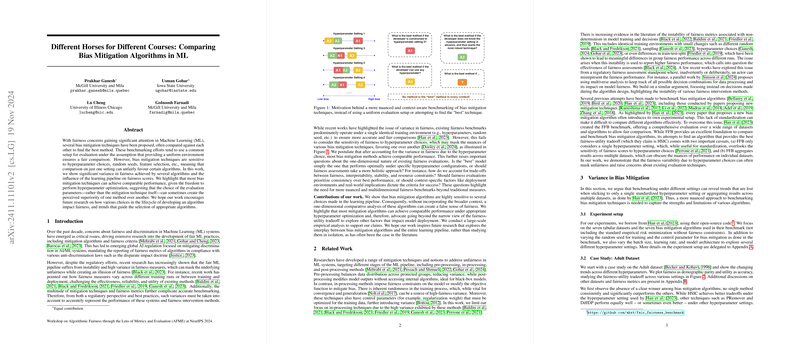Evaluating Bias Mitigation Algorithms in Machine Learning
The paper "Different Horses for Different Courses: Comparing Bias Mitigation Algorithms in ML" presents a critical examination of the practices commonly employed in benchmarking bias mitigation techniques in ML. The authors challenge the prevailing approach of evaluating these algorithms under a uniform experimental setup, arguing that such practices can mask the true variability in fairness outcomes and unfairly advantage certain methods over others.
Core Contributions and Methodology
This paper addresses the inherent variability of fairness achieved by bias mitigation algorithms when different hyperparameters, random seeds, and feature selection methods are employed. It advances the notion that many of these algorithms can perform comparably well when given the opportunity for hyperparameter optimization. This is a vital observation because it shifts the focus away from the pursuit of a singularly superior algorithm and towards understanding the contexts in which different algorithms excel.
The experimental framework of this research encompasses seven popular bias mitigation algorithms applied across multiple datasets under varying hyperparameter settings. The datasets include well-known benchmarks like Adult, COMPAS, and several others, thereby ensuring comprehensive coverage of diverse data characteristics. The comparison spans various fairness metrics, such as demographic parity and equalized odds, to provide a nuanced understanding of how each algorithm performs under different fairness definitions.
Key Observations
- No Dominant Algorithm Across All Settings: The analysis clearly demonstrates that no single bias mitigation algorithm consistently outperforms others across all datasets and hyperparameter configurations. While some algorithms may excel in particular settings, their performance is not universally superior.
- Impact of Hyperparameter Tuning: By optimizing hyperparameters, the comparison reveals that many algorithms achieve competitive trade-offs between fairness and utility. This emphasizes that fairness evaluations should consider hyperparameter tuning as a critical component of the model development lifecycle.
- Context-Specific Evaluation Needed: The paper calls for a reevaluation of the criteria used in selecting bias mitigation techniques. It suggests that beyond fairness and utility trade-offs, factors such as runtime efficiency, theoretical guarantees, and robustness to multiplicity should inform decision-making.
- Algorithm Sensitivity to Data Properties: The performance variations observed across datasets indicate that specific algorithmic decisions, such as input feature representation and model complexity, have a substantial impact on the effectiveness of fairness interventions.
Practical and Theoretical Implications
This work holds significant implications for both practitioners and theorists in the field of fair ML. For practitioners, it underscores the importance of tailoring algorithm choices to specific deployment contexts and conditions, rather than defaulting to popular algorithms based on limited benchmarks. For theorists, it highlights the need for developing new theoretical frameworks that account for the full spectrum of model development choices, including those related to data processing and hyperparameter configuration.
In particular, the results presented in this paper advocate for a move away from one-dimensional benchmarks toward more comprehensive, context-aware evaluation frameworks. Such frameworks should provide insights into how different algorithms behave under diverse settings and facilitate informed decisions that balance fairness, interpretability, scalability, and other considerations relevant to real-world applications.
Future Directions
The paper opens several avenues for future research. A natural extension involves exploring bias mitigation strategies beyond in-processing techniques, encompassing pre-processing and post-processing methods. Additionally, further investigation into consistent trends that guide hyperparameter choices across different datasets may improve the repeatability and robustness of fairness assessments. Finally, examining decision-making processes across the entire lifecycle of ML algorithms can lay the groundwork for more holistic approaches to ensuring fairness.
In summary, the paper's critical analysis challenges existing norms in comparing bias mitigation algorithms and advocates for a more nuanced understanding of fairness evaluations—anchored in the complexities of real-world ML applications.
